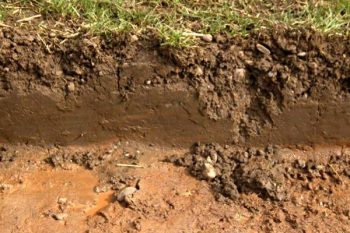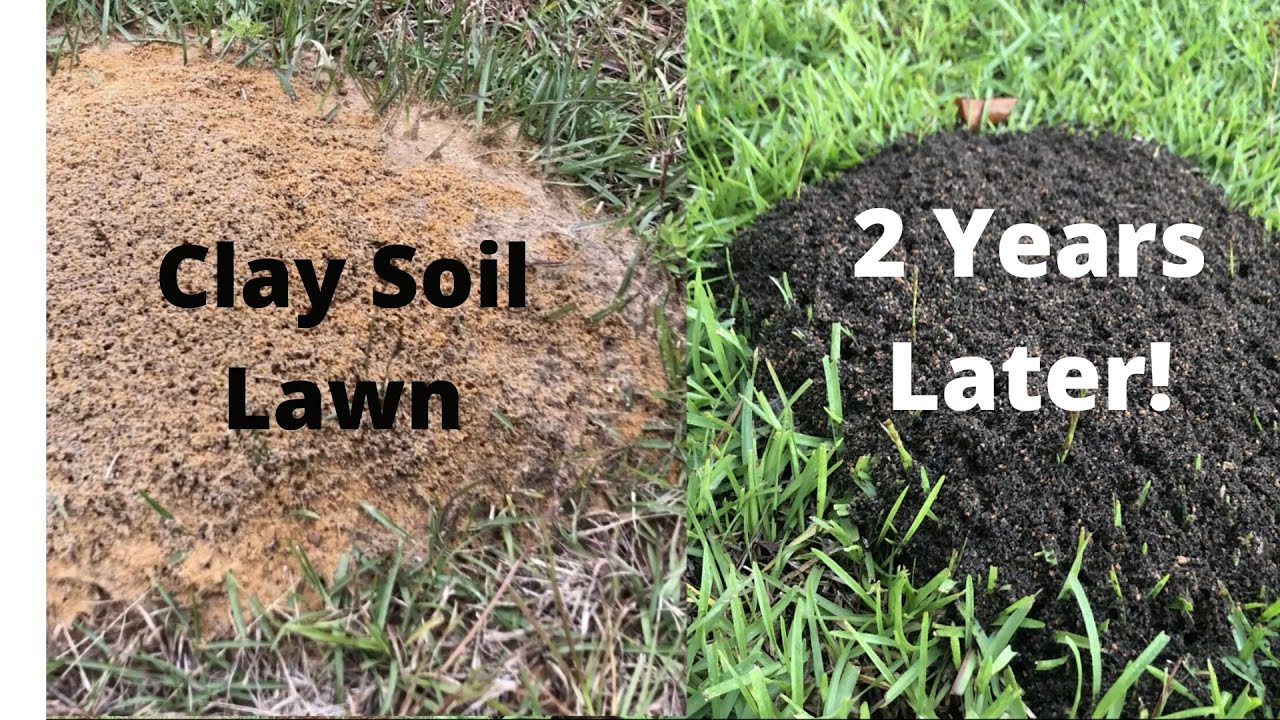To improve clay soil for lawns, add organic matter and regularly aerate the soil. Choose deep-rooting grass species to enhance structure and drainage.
Amending poor soil quality is essential for a lush, vibrant lawn, especially when dealing with heavy, compacted clays. Homeowners often struggle with clay soil because it can be dense, slow to drain, and challenging for grass roots to penetrate. Improving clay soil requires patience and the right approach.
Introducing well-decomposed organic matter, such as compost or aged manure, can significantly boost soil structure and fertility. Regular aeration, a process that creates small holes in the soil, promotes oxygen and water penetration, benefiting root development and microbial activity.
The selection of grass varieties that thrive in clay conditions is another strategic move, with species like tall fescue known for their deep roots which can break up compacted soil over time. These deliberate actions create a more hospitable environment for your lawn by enhancing drainage, nutrient availability, and overall soil health.

Credit: www.natureslawn.com
The Challenge With Clay Soil
Preparing a lush, green lawn starts with understanding your soil. Clay soil poses unique challenges that can hinder this dream. Figuring out how to improve clay soil for a vibrant lawn is essential. Let’s delve into these challenges and find solutions.
Characteristics Of Clay Soil
- Dense and compact: Difficult for roots to spread.
- Slow drainage: Water sits on the surface longer.
- Sticky when wet: Hard to work with.
- Hard and cracked when dry: Limits air and water flow.
Impact On Lawn Health
Clay soil affects lawn growth. Grass struggles to penetrate the soil. This can lead to weak roots and poor health. Lack of drainage also causes waterlogging. It can suffocate roots and promote disease. Here’s a table illustrating the effects:
| Soil Issue | Lawn Impact |
|---|---|
| Dense Texture | Impedes root growth |
| Poor Drainage | Encourages moss and fungi |
| Compactness | Prevents nutrient uptake |
| Hard when Dry | Leads to aeration issues |
Benefits Of Amending Clay Soil
Creating the perfect lawn starts from the ground up, quite literally. Amending clay soil transforms it into a vibrant foundation that supports lush, green grass. Let’s explore how improving clay soil can significantly boost your lawn’s health and aesthetics.
Enhanced Root Development
Strong roots equal a strong lawn. Amending clay soil improves its structure, making it easier for grass roots to spread and absorb nutrients. This results in a more robust and resilient turf.
By incorporating organic material such as compost or aged manure, you enable roots to:
- Grow deeper, for better stability
- Access more nutrients, for vibrant growth
- Withstand drought, by reaching moisture held deep in the soil
Improved Drainage And Aeration
Waterlogged grass can spell disaster for your lawn. Fortunately, amending clay soil can save the day by enhancing drainage and aeration. A well-draining lawn prevents water from pooling, protecting your grass from root rot and disease.
Here are ways how amending with sand, gypsum, or organic matter can help:
- Prevent puddles, keeping the surface dry and even
- Allow air to circulate, supplying the roots with oxygen they need
- Facilitate nutrient uptake, because root-accessible nutrients dissolve in well-drained soil
Initial Assessment
Kicking off your lawn renovation starts with an Initial Assessment of your clay soil. Understanding your soil’s needs begins with two critical steps: Testing Soil Composition and Identifying Drainage Issues.
Testing Soil Composition
Start by grabbing a handful of soil from your lawn. Does it feel gritty or smooth? The texture tells you a lot. A simple jar test can unveil the soil’s secrets. Here’s a quick method:
- Fill one-third of a clear jar with soil.
- Top it off with water.
- Shake vigorously and let it settle for 24 hours.
Examine the layers that form. Sand settles at the bottom; silt in the middle; clay on top. A larger clay layer means you’ve got your work cut out.
Identifying Drainage Issues
Good drainage ensures a healthy lawn. Conduct a simple test:
- Dig a hole one foot deep and wide.
- Fill it with water and wait for it to drain completely.
- Refill the hole and measure how fast it drains.
If the water takes more than four hours to drain, you have a drainage problem. Solutions like adding organic matter or aeration can improve this condition.
With these assessments, crafting a clear plan to enhance your clay soil becomes much easier.
Physical Improvements
Physical improvements to clay soil transform a lawn’s base. They make roots grow deeper. The soil gets healthier. Ready to find out how? Let’s dig in!
Aeration Techniques
Aerating your lawn means making holes in the soil. It allows air and water to reach the roots.
- Core aeration pulls out small soil plugs. It’s great for compacted clay.
- Spike aeration makes holes using solid spikes. It’s quick and easy.
Use aerating tools once a year for best results.
Vertical Drainage Solutions
Vertical drainage beats the slow nature of clay. It moves water down fast.
| Method | Benefit |
|---|---|
| French drains | Carry water away from the lawn. |
| Perforated pipes | Collect and redirect water. |
| Dry wells | Store excess water underground. |
Choose the right method to prevent waterlogging.
Organic Amendments
Healthy lawns begin with healthy soils. Transforming hard, compact clay into rich, living earth provides the foundation for a lush, green lawn. Organic amendments are key. They add essential nutrients and improve soil structure.
Choosing the Right Organic Materials
Choosing The Right Organic Materials
Organic materials are like vitamins for soil. They make the earth breathe and feed grass roots. Compost, manure, and leaf mold lead the pack. They work wonders for clay soils.
- Compost: A mix of decayed plants and kitchen waste
- Manure: Animal poop, packed with nutrients
- Leaf Mold: Broken-down leaves, a magic touch for structure
Always use well-rotted materials. They should smell earthy, not sour or like ammonia.
Proper Application Methods
Proper Application Methods
Application makes all the difference. Good methods let roots get food and air.
- Timing: Apply in early spring or fall.
- Quantity: Spread a layer 2-3 inches thick.
- Working In: Mix into the top 6-8 inches of soil.
| Material | Depth | Mixing Depth |
|---|---|---|
| Compost | 2-3 in | 6-8 in |
| Manure | 2-3 in | 6-8 in |
| Leaf Mold | 2-3 in | 6-8 in |
After applying, water the lawn. This helps materials settle and start helping your soil.

Credit: www.rynolawncare.com
Chemical Conditioners
Healthy lawns start from the ground up, and clay soil often needs a helping hand. Chemical conditioners can transform your hard-to-manage clay into a rich foundation that’s ready for lush grass. These conditioners adjust the soil’s structure and pH, leading to better nutrient availability and root penetration.
Lime And Gypsum: When To Use Them
Understanding your soil’s needs is key before picking a conditioner. When your soil is too acidic, lime steps in to correct it. Gypsum, on the other hand, addresses heavy clay soils by improving their structure and drainage. Let’s look into their best uses:
| Lime | Gypsum |
|---|---|
| Raises soil pH | Loosens soil structure |
| Enhances nutrient availability | Reduces soil compaction |
| Ideal for acidic soils | Perfect for heavy, wet soils |
Balancing Soil Ph For Optimal Growth
Perfect pH balance is vital for a green and healthy lawn. Grass thrives in slightly acidic to neutral pH levels, typically between 6.0 and 7.0. Use a simple soil test kit to determine your lawn’s current pH level.
- A pH below 6.0 could benefit from lime applications.
- Above 7.0 might need sulfur to lower the pH.
- Staying within the ideal pH range ensures nutrients are accessible to your grass.
Remember, applying lime or gypsum without knowing your soil’s pH can do more harm than good. Always test first for a beautiful and thriving lawn.
Long-term Maintenance
Thriving lawns rely on healthy soil as their foundation. The journey to improve clay soil for lawns is ongoing. What you do regularly can make or break your lawn’s success. Consider long-term maintenance as your garden’s personal fitness plan. It involves commitment, care, and constant attention.
Regular Aeration Schedules
Aeration is vital for clay soil. It allows grass to breathe and grow deep roots. Think of it like poking holes in a sponge to let air in. Plan to aerate your lawn twice a year. Do it during the growing season. This helps water, nutrients, and air reach the roots of your grass, making them stronger and healthier.
Consider these steps for aeration:
- Mark the sprinklers to avoid damage.
- Water the lawn to soften the clay.
- Use a core aerator for best results.
- Leave the soil plugs on the lawn to break down.
Continual Organic Matter Addition
Organic matter improves soil structure. It’s like giving vitamins to your lawn. This matter includes compost or well-rotted manure. Spread it over your lawn once a year, ideally after aeration. This enriches the soil and helps create a healthy, lush lawn.
| Type of Organic Matter | Benefits |
|---|---|
| Compost | Boosts nutrient content, encourages worms, and fosters microorganisms. |
| Manure | Adds nitrogen, which is like a growth superfood for grass. |
| Leaf Mold | Improves water retention and soil structure. |
Spread organic matter evenly across the lawn. Use a shovel and rake for distribution. Aim for a thin layer, about half an inch thick. This will support grass growth and improve soil fertility.

Credit: www.alsoils.co.uk
Grass Selection For Clay Soils
Best Grass Types For Heavy Soils
Let’s talk about the super grass heroes that thrive in tough clay conditions.
- Tall Fescue: Deep roots break through tough clay.
- Bermuda Grass: Heat lover and drought tolerant.
- Zoysia Grass: Slow growth means less mowing.
- Buffalo Grass: Low maintenance and sturdy.
Seed Vs. Sod: What Works Better?
Deciding between seed and sod depends on your needs and patience. Here’s a quick overview:
| Seed | Sod |
|---|---|
| Cheaper | Instant lawn |
| More varieties | Less weed competition |
| Takes time to establish | Needs good soil contact |
In clay soils, starting with sod can provide a quick solution for a bare lawn. Seeding, though slower, lets you choose specific grass types for clay resilience.
Irrigation Strategies
Turning clay soil into a lush lawn starts with the right water touch. Clay can be tricky, as it holds moisture tight, but with smart moves, grass can thrive. Let’s dive into the world of irrigation strategies for clay-rich yards.
Effective Watering Practices
Knowing when and how much to water is key. Here’s how to do it right:
- Check the soil first. Stick a finger two inches down. If it’s dry, it’s time to water.
- Go for morning sessions. Watering early cuts evaporation and disease chances.
- Keep it deep but infrequent. Longer intervals between watering encourage strong root growth.
- Aim for one inch a week. Use a rain gauge or empty tuna cans to track the amount.
- Adjust for the weather. Hot or windy days may need more water; cool or rainy less.
Smart Irrigation Systems
Modern tech meets lawn care. Smart sprinklers adjust water levels for you. Here’s why they shine:
| Feature | Benefit |
|---|---|
| Sensor-based adjustments | Tailors watering to the weather and soil moisture |
| Programmable schedules | Fits your lawn’s unique needs |
| Remote control access | Manage your lawn’s hydration from anywhere |
A smart system can save water and money while giving grass the best chance to flourish in clay soil.
Monitoring Soil Health
Healthy soil is the secret to a lush, green lawn. Monitoring Soil Health ensures your grass gets what it needs to grow. Understanding the current state of your soil is the first step to improvement. In this section, learn how to keep your soil in top shape with simple, effective methods.
Periodic Soil Testing
Regular soil tests guide you in nourishing your lawn. They show what your soil lacks and what it has in abundance. Follow these steps to test your soil:
- Gather soil samples from different lawn areas.
- Send samples to a local extension service or use a home testing kit.
- Review the results for pH level and nutrients like nitrogen, phosphorus, and potassium.
With these results, tailor your soil improvement plan. Aim for a pH between 6.0 and 7.0, which is ideal for most lawns.
Adjusting Maintenance Routines
To improve clay soil health, change how you care for your lawn. Use these tips to adjust your routine:
- Mow properly: Keep grass at the right height to protect soil.
- Water wisely: Over-watering can compact clay soil, so water less often but deeply.
- Aerate: Loosen the soil to allow air, water, and nutrients to penetrate.
- Add organic matter: Compost and mulched leaves improve soil structure and nutrition.
This care keeps roots strong and soil fertile. Make these changes part of your ongoing lawn care strategy.
Common Mistakes To Avoid
The quest for a lush lawn starts with the soil beneath it. Clay soil can be a challenge. to ensure a healthy, robust lawn.
Over-fertilization Pitfalls
Over-fertilizing often harms more than helps. It leads to:
- Excess growth: Plants work too hard, becoming weak.
- Root damage: Fertilizer burn can occur.
- Pollution: Run-off contaminates waterways.
Follow these simple steps:
- Use soil tests to determine nutrient needs.
- Apply fertilizer at recommended rates.
- Choose slow-release options to avoid shock.
Poor Water Management
Clay soil has water retention issues. Keep these tips in mind:
- Aerate:
- Improves water penetration.
- Water deeply and less often:
- Encourages deep root growth.
- Avoid overwatering:
- Roots can suffocate.
Remember, healthy lawns start with understanding your soil’s unique needs. Bypass these over-fertilization and water management errors to give your lawn the best chance to thrive.
Case Studies
Success Stories
In Minnesota, one homeowner triumphed over dense clay soil. They turned a barren yard into a lush green space. Their secret was organic matter integration. Over two years, they added compost twice annually.
Another success story comes from Oregon. Regular aeration and the addition of sand and peat moss led to improvement. Within 18 months of consistent care, their lawn was completely transformed.
Techniques In Different Climates
In warm, wet regions, such as Florida, solving clay soil issues demands unique approaches:
- Frequent aeration to combat compaction.
- Use of fast-draining soil amendments like calcined clay.
In contrast, arid areas like Arizona rely on regular organic material incorporation. Gypsum is also a hero ingredient in desert climates. It helps break up heavy soil without affecting pH.
| Climate | Technique | Duration |
|---|---|---|
| Temperate | Compost and mulching | 1-2 years |
| Wet | Sand and peat moss | 6 months – 1 year |
| Arid | Gypsum and organic matter | Continuous |
Frequently Asked Questions
Will Grass Grow In Clay Soil?
Grass can grow in clay soil, but its dense nature may require soil amendment for better root penetration and drainage. Regular aeration and adding organic matter can help improve growth conditions for grass in clay soil.
Can I Put Topsoil On Top Of Clay Soil?
Yes, you can add topsoil over clay soil to improve drainage and soil structure. Mix the topsoil thoroughly with the clay for best results.
What Is The Best Lawn Fertilizer For Clay Soil?
The best fertilizer for clay soil is one rich in organic matter, like compost, or a balanced slow-release granular fertilizer with a 4-1-2 ratio.
Conclusion
Embracing the steps to enhance clay soil turns a challenging lawn into a lush landscape. Remember: regular aeration, organic amendment integration, and proper watering transform your turf significantly. For green, healthy lawns, your efforts in soil improvement will surely reap visible rewards.
Keep nurturing your garden; the results are worth it!





